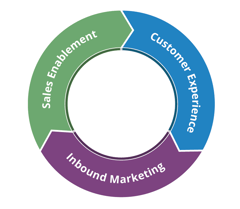In today’s hyper-competitive, data-obsessed marketing landscape, CMOs and growth leaders are under constant pressure to deliver immediate results while still building a brand that lasts. But here’s the hard truth: if you treat brand and performance as opposing forces, you’re setting your strategy up to fail. The most successful marketing organizations don’t choose between brand and performance, they find ways to make them work together. Brand drives recognition, trust, and long-term value. Performance delivers the short-term metrics your board cares about. When these two streams align, marketing becomes a compounding engine rather than a zero-sum game.
In this blog, you’ll find 16 expert-backed strategies from marketing leaders who have mastered the art of integrating brand and performance. From designing dual-purpose campaigns to adapting your strategy to your company’s growth stage, these are practical, proven ideas you can implement right away:
- Treat Brand as Fuel for Performance
- Link Brand Metrics to Performance Outcomes
- Embed Brand in Every Performance Touchpoint
- Integrate Credibility Sequencing in Advertising
- Blend Brand Storytelling with Conversion Content
- Plan Campaigns with Dual Goals
- Allocate Measurable Percentages to Both Streams
- Focus Short-Term on Existing Audience
- Approach Marketing like a Balanced Portfolio
- Use Provisional Branding for Consistent Evolution
- Design Dual-Purpose Campaigns with AI Support
- Combine Influencer and Performance Channel Strategies
- Bridge Brand and Performance via Social Media
- Track Brand Health Alongside Performance Metrics
- Embed Brand Elements in All Initiatives
- Adjust Strategy Based on Company Lifecycle
Treat Brand as Fuel for Performance
One way I've found to balance brand-building with short-term performance goals is to treat brand as the fuel, not the finish line. When I worked with a SaaS client obsessed with quick conversions, we reframed their quarterly targets so 70% of the budget went toward direct-response campaigns and 30% went into consistent, brand-driven content. But here's the catch — every brand touchpoint had a measurable micro-conversion baked in: a download, an email signup, a webinar registration. That way, brand-building wasn't just "long-term goodwill," it was actively feeding the performance funnel. The result? Within a year, their lifetime customer value tripled, and they still hit their monthly lead targets. If you make brand and performance compete for budget, one will always starve. If you make them feed each other, both grow.
Peter Lewis, Chief Marketing Officer, Strategic Pete
Link Brand Metrics to Performance Outcomes
The only way to balance brand and performance is to start with a clear, testable hypothesis about how your brand metrics actually influence performance outcomes. Many teams I encounter talk about "brand lift" as if it's a virtue in itself. It's not. You need to define exactly which brand attributes (e.g., trust, recall, perception of speed or innovation, etc.) you believe will move the needle on mid-funnel or conversion behaviors, and then you need to prove it. Run split geos, track assisted conversions, measure time-to-purchase deltas, etc. Once you establish the link between brand health and revenue performance, it's no longer a trade-off and becomes a compounding system. The mistake I see all the time is thinking of brand as a separate, slower track. Smart marketers bake it into performance creative, then track both in the same dashboard.
Lars Nyman, Chief Marketing Officer, Nyman Media
Embed Brand in Every Performance Touchpoint
One effective way to balance brand-building with short-term performance is to design campaigns that do both simultaneously, treating brand as something embedded in every performance touchpoint. For example, ads can be optimized for conversions while still reinforcing the same tone, message, and visual identity. When people see consistent language, creative style, and point of view across channels, it builds familiarity. That familiarity lowers CAC over time because people are more likely to click when they recognize who's speaking to them.
Instead of splitting time between brand and performance, the goal is to make performance work in a way that also builds memory. Repeating phrases, using distinct visuals, and keeping the narrative tight helps create pattern recognition. People remember how something made them feel or what stood out. Even in testing, it's possible to measure brand impact. Beyond CTR and conversion rates, things like scroll depth, watch time, and return visits can show whether the message is sticking. Strong creative doesn't just drive action; it leaves an impression that makes the next interaction easier. If a campaign only performs in the short term but doesn't build any equity, it's not sustainable. And if it only builds brand without driving results, it's not practical. So the real value comes from work that does both by design.
Josiah Roche, Fractional CMO, JRR Marketing
Integrate Credibility Sequencing in Advertising
Marketing leaders often struggle with the tension between long-term brand investments and immediate performance metrics. In my experience with a wellness brand, we found success by integrating both objectives through what we called “credibility sequencing” in our advertising approach. Rather than pushing product features, we showcased authentic customer transformation stories that acknowledged initial skepticism before revealing solutions. This strategy simultaneously built brand trust while delivering measurable results, leading to a 28% increase in conversions and reducing our cost-per-acquisition by a third. The key insight was recognizing that brand-building and performance marketing aren't opposing forces but complementary elements that, when aligned properly, create a more powerful overall marketing strategy.
Jock Breitwieser, Digital Marketing Strategist, SocialSellinator
Blend Brand Storytelling with Conversion Content
One highly effective way marketing leaders can balance brand-building with short-term performance goals is by integrating brand storytelling into performance channels, especially paid social, email, and landing pages. Instead of treating brand and performance as separate efforts, smart marketers embed brand values, tone of voice, and emotional messaging into conversion-focused content. For example, a paid ad might drive email signups (a short-term KPI), but still tell a compelling story that reinforces brand identity and long-term trust.
Why this works:
- It drives immediate action and builds long-term recognition.
- It creates consistency across the funnel — from top to bottom.
- It avoids the trap of "brand campaigns no one sees" and "performance campaigns no one remembers."
Alan Ward, Marketer, Brew House Creative
Plan Campaigns with Dual Goals
Rather than treating brand initiatives and performance marketing as separate tracks, forward-thinking organizations blend the two within unified campaigns designed with interlocking objectives. For instance:
- Deploy impactful video or authentic storytelling at the top of the funnel to ignite brand awareness and resonate emotionally.
- Subsequently, retarget those who have engaged with branded content using high-conversion performance advertising further down the funnel.
- Apply multi-touch attribution models to accurately track how brand interactions influence conversion outcomes throughout the customer journey.
A truly integrated campaign does not require choosing between brand and performance or sacrificing one for the other. Instead, it unites both strategies—each amplifying the other’s effect at every stage of the funnel. Your brand strategy attracts prospects and fosters trust, while your performance strategy motivates those prospects to convert. Together, they create a continuous cycle that propels business growth and ROI.
Rich Meyer, VP of Marketing, Prism Global Marketing Solutions
Allocate Measurable Percentages to Both Streams
Many marketing executives distinguish between brand building and performance campaigns, but I observe better outcomes when the two work together. When I set up a token sale in the blockchain industry, 60 percent of the resources were allocated to conversion-oriented initiatives such as exchange partnerships and advertising campaigns, while 40 percent went toward founder interviews and thought leadership in tier-1 publications. This approach resulted in an immediate reception that provided the project with $12 million of investment within two weeks, and the media coverage remained positive even after the sale concluded.
There is a need to balance these two aspects by considering brand efforts as a means to drive performance rather than an additional cost. An article in an international publication can maintain investor confidence for months, whereas paid campaigns cease the instant the budget is exhausted. My rule is to always allocate measurable percentages between the two streams, as this ensures that short-term goals are fulfilled while the brand narrative gains long-term sustainability.
Suvrangsou Das, Global PR Strategist & CEO, EasyPR LLC
Focus Short-Term on Existing Audience
The key is not to put all your eggs in one basket. Brand-building takes time, and if done correctly, can turn into an easy-button lead machine where you don't have to do any work. But that doesn't happen overnight. For short-term performance goals, focus on the people you already have. Do you have a large audience on LinkedIn? Focus on those people. Perhaps your email list has a high conversion rate. Great, invest your time there.
Understand that brand building is the long-term plan and goal, and probably won't help you with your short-term performance. Your marketing efforts need to be hyper-focused in the short term on the audience you already have, while in the background, you work on that top-of-funnel content to reach the audience you want to have.
Garrett Carlson, Content Marketing Manager, The Loop Marketing
Approach Marketing like a Balanced Portfolio
The best way any marketer can balance brand-building with short-term performance goals is to approach it like a balanced investment portfolio. Your blue-chip stocks are your brand-building efforts; they deliver steady returns over time through building trust, awareness, and customer loyalty. Your high-yield bonds are your performance campaigns; they immediately move the needle, spiking the chart. However, they are unable to sustain you alone.
For instance, you can launch a podcast series featuring experts within your niche; this is brand building. Simultaneously, you can run targeted retargeting ads to capture leads from those listening to the podcast, addressing the short-term performance goal. Essentially, they are two different sides of the same coin; they feed from each other. The stronger your brand, the better your conversions will be, and the more effective the performance spend.
The challenge is, once you get a quick win, most tend to focus all their efforts on it. Relying solely on short-term gains means there is no long-term growth; in other words, it's not sustainable. So, it requires a dedicated, consistent effort in both areas if you want to ensure long-term success.
Josh Eberly, Chief Marketing Officer, Marygrove
Use Provisional Branding for Consistent Evolution
We use a provisional branding approach to keep short-term performance campaigns aligned with long-term brand goals. We start with the core elements we already have, such as our logo, color palette, typography, brand voice, and layout, and we apply them consistently across all campaigns. As new messaging or content needs arise, we expand the brand guidelines in real-time so the identity evolves without losing coherence.
To keep a fast-moving team aligned, we use tools like Adobe Express to store brand assets and convert high-performing designs into locked templates. This allows multiple contributors to create on-brand content quickly while giving key brand owners control over strategic updates. We also run regular creative reviews where marketing and product teams check each other's work for brand consistency and look for ways to improve the overall presentation.
Another key is to build campaigns with dual intent so every short-term promotion also reinforces a brand story. For example, an ad aimed at immediate sign-ups should also carry visuals and messaging that deepen recognition of the mission and values of the company. This ensures that performance activity is adding to long-term equity instead of working in isolation. By combining a living brand system with the discipline of consistent reviews and the mindset of dual-purpose campaigns, we are able to move quickly for performance while continuing to strengthen the brand foundation we will rely on in the future.
Caleb Kingston, Co-Founder and CEO, HubHive
Design Dual-Purpose Campaigns with AI Support
Design campaigns that serve both purposes from the start. Look for ways to infuse brand assets, voice, and positioning into every performance campaign — and leverage AI tools to help you do it at scale. AI can power highly personalized content that engages audiences in direct, relevant ways, improving short-term performance results. At the same time, it enables you to produce content consistently and at volume, creating the steady stream of brand touchpoints that compound equity over time. The better your brand content and campaigns are, the better your demand campaigns will perform — and a truly strong brand is one that also delivers strong demand metrics. This approach ensures every dollar you spend works twice as hard — driving immediate results while steadily strengthening the brand that will fuel your future growth.
Josh Ritchie, Cofounder, Column Five
Combine Influencer and Performance Channel Strategies
Balancing brand building with performance goals requires a smart budget strategy. Marketers can allocate funds to influencer marketing, where credible voices elevate brand equity, while directing the rest toward performance channels such as PPC, social media marketing, content marketing, and SEO, which are proven to generate quick returns.
Farhan Sheikh, Chief Marketing Strategist, SEOLHR
Bridge Brand and Performance via Social Media
Use social media as the bridge. Keep an always-on brand narrative running across channels, but build in seasonal or trending content that can deliver quick results. Repurpose assets across your site, email, and ads so your message is consistent everywhere. The brand gets reinforced over time, but you're still hitting short-term performance targets with campaigns that feel natural, not one-offs.
Geoffrey Bourne, Co-Founder, Ayrshare
Track Brand Health Alongside Performance Metrics
I make brand health part of the performance scorecard. Alongside ROAS and conversion rates, we track things like branded search volume, repeat visits, and how often people mention us online. If those brand signals aren't improving, then the short-term wins are just quick sugar highs that won't last.
Lisa Frank, Marketing Specialist, AM Industrial Group
Embed Brand Elements in All Initiatives
Balancing brand-building with short-term performance is much like managing your health; you can't focus solely on today's workout without considering your long-term well-being. The challenge lies in ensuring that every short-term push connects directly to your brand's core story. If a campaign drives results but doesn't reflect your identity or values, it might succeed in the moment but weaken you in the long run.
That's why I believe in embedding brand elements into every performance initiative. Even if the goal is purely transactional, such as boosting signups or sales, the creative should still convey the brand's tone, personality, and purpose. It's not about sacrificing performance for the sake of branding, but rather ensuring that performance work is part of the brand's ongoing narrative.
When done right, this approach creates a compounding effect. Each short-term win strengthens the brand, and the stronger the brand becomes, the more effective the next campaign will be. Over time, you're not just stacking quick results; you're building a reputation that keeps paying dividends.
Máté Kovács, Founder, Teleprompter.com
Adjust Strategy Based on Company Lifecycle
Marketers need to consider how they are going to approach marketing. It must be based on the present lifecycle of the company. A startup must focus on short-term performance marketing, with an emphasis on customer acquisition, sales, and generating quick revenue using paid promotions or targeted ads. Every marketing dollar should be spent with a measurable goal in mind.
Once a startup or a business grows, the focus should be on brand-building. While the short-term goals are still important, the priority now changes to connecting with customers emotionally and building brand recognition, which focuses on long-term value. At this stage, storytelling, public relations, and content marketing take over traditional marketing.
Adjust your model based on the stage of the company. If you are in the early stage (startup), prioritize performance and make sure to take opportunities for quick returns. Once the business matures and is more stable, focus your time and effort on brand building. Strong brands have strong business foundations.
John Beaver, Founder, Desky
In a world where marketing teams are expected to deliver both lightning-fast results and long-term brand equity, the most effective strategy isn’t choosing between brand and performance, it’s aligning them to work in concert. As the experts featured in this blog make clear, treating brand as fuel for performance, embedding identity into every touchpoint, and tracking both with equal rigor turns marketing into a compounding growth engine.
The strategies shared here aren't theory, they’re real-world, tested tactics from marketing leaders who’ve faced the same pressure you do. Whether you’re in a high-growth startup chasing leads or a mature company looking to deepen trust, the key is to design campaigns that work twice as hard, building memory and momentum.
The future of marketing doesn’t pit brand and performance against each other. It demands that you master both.
If you're interested in discussing ways to successfully balance your brand-building and performance goals, we invite you to schedule an inbound marketing consultation.


.png?width=80&height=80&name=diamond-badge-color%20(1).png)
__Square.png?width=250&height=250&name=Marketing_Hub_(1)__Square.png)




.png?width=250&name=diamond-badge-color%20(1).png)
